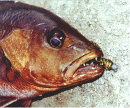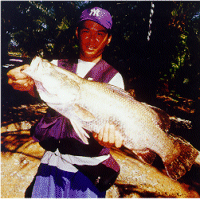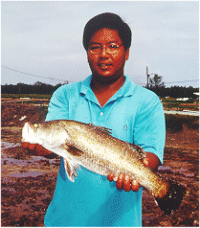



 Soft Plastics - Still going strong!
Soft Plastics - Still going strong!
by Chris Tan It has been well over a year since my article on soft plastic lures was published. Since then, these lures have had a growing following of users. One application of fishing which these lures have been found deadly, in the commercial saltwater ponds for anglers in the coastal region of Selangor. A new fishing hole It all started out when a commercial pond was opened up in Kuala Selangor that allowed the use of lures, but only lures that have single hooks. Treble hooks are not permitted. I was introduced to this place by a couple of friends. Although I am not a big fan of commercial ponds of any sort, I was going through a dry spell of fishing and running out of fishing spots within the Klang Valley to frequent. I normally prefer to pit my wits against the wild unknown, but finding such spots close by, for half a day's fishing is pretty tough these days, for those of us who reside in the Klang Valley, not to mention the freezer needed to be filled. So with my tackle box filled with my favourite soft plastics, G.P. Goh and I headed up north early one morning. This saltwater pond was actually dug out within the mangroves and had a little mangrove island in the middle, full of snags and holes. A nice place to hang up lures with badly aimed casts! Why soft plastic lures There were a couple of reasons why the soft plastics lures were chosen to be used here. First, if the lure is snagged on a branch upon the cast, and if it cannot be recovered, losing it is not as expensive as losing a hard bodied minnow lure! (At that time hard bodied lures could be used if the treble hooks were replaced with single hooks) Second, if the lure is lost when a fish takes it away for keeps, it is affordable. Third, because of the type of jigs hooks used, the hook point rides up, minimising the chances of getting snagged. The prime reason for using them, was these soft plastics worked very well! So my friends assured me, which was not surprising as we had been catching wild siakap (kakap putih) on them. Well, that was fine with me, a proponent of the soft plastic lures. In the beginning it was pretty slow. Being new to the place I had to work the place, searching for the spots the fishes would hang out. I had a close swirl within the first quarter of an hour. A good sized siakap turned and rolled, flashing its silvery maroon body at me. It took a close look at my lure, but obviously was not enticed enough to put the lure in its mouth! An hour and several small bumps later and one lure less, left hanging onto a branch on the little mangrove island, I was still working right within the snags. I had a few bumps and nudges from a few curious fish. G.P. was not having much better fortune than I was. It looked like the fish were on a diet that morning, being fussy and picky about their victuals. Fish on! Changing tactics, I started casting to open water. As soon as the lure landed, I was immediately rewarded with a severe bump! I quickly set the hook and gently played the fish in, steering clear of snags in those snag infested waters. Why do I say "gently"? Well, although I was using 12lb line, The jig hooks I was using were rather soft, made of bronze that easily straighten. After a minute or so, I managed to manoeuvre my mangrove jack (kakap merah) into my landing net. Keep it smooth In the meantime, G.P. was also having success on the other side of the pond. He had landed a siakap. I continued to work around the pond, hooking up another mangrove jack. Right within the snags. I immediately applied pressure, by smoothly pumping the rod and cranking, allowing the reel drag to slip each time I would lift the rod, and cranking the reel handle as I lowered the rod. I do not believe in locking up the drag, and hanging on for dear life! It does not do any good in snag infested territory. All the fish has to do is swim side ways into a snag! The constant change of pressure by pumping the rod tends to disorient the fish, throwing it off, forcing it to change direction and finally leading it out into open water. This one was successfully landed, after a few heart stopping moments, as it struggled for survival within the snags!  GP managed to bring in 3 fish, one jack and two siakap that morning. I had
those two jacks of my own. Not fantastic but sufficient to keep us
satisfied.
GP managed to bring in 3 fish, one jack and two siakap that morning. I had
those two jacks of my own. Not fantastic but sufficient to keep us
satisfied.
About two weeks later I had another invitation to visit the same pond from a couple of friends, this time to fish there in the evening. I figured the freezer needed filling up again so I tagged along. This trip one of my friends decided to bait fish the whole time, while the other chap varied his fishing between bait fishing and casting. Initially bait fishing seemed to be the most successful method, producing quite a number of small siakap and one jack. Casting soft plastic lures seemed to be unsuccessful that day. After 2 hours without so much as a bite or nudge I had decided to accept the fact I would probably go home empty handed that day. Keep the rod tip low I was casting sombrely to a patch of open water, when suddenly almost at my feet, something slammed my lure and took off! Fortunately into snag free water! Then it jumped! A siakap! A big one! Visions of the siakap throwing the hook during one of its head shaking jumps reminded me to lower my rod tip right to the water level. That stopped it from doing anymore jumps. I continued to fight with my rod tip low down, and even in the water at times. At the same time I had to steer it clear of the dead branches on my left. It took almost 5 minutes to land. Trying to net a green fish is almost impossible. As soon as the fish is brought in close, it takes off again when it sees the angler. The trick is to keep playing the fish smoothly, by changing the angle of the rod, from side to side, never giving it a chance to rest. If at any time the rod is just being held motionless, it means the fish is getting to rest. The longer the fish is out there, it is keeping its strength up, the greater chance it has of getting loose! Within the last one hour I managed to hook up and land two more siakap. The average size was 2 kilos each. My friend using bait landed quite a few more siakap, about 7 or so, but all well below the one kilo weight. After this trip, I took quite a long break from commercial pond fishing. Although it was quite thrilling and exciting, something was missing. I guess fishing in a stocked pond is just not the same as fishing the wild fish. I can't stay away  A few months later, my fishing buddy Chris Chandran called me to inform me
of two new saltwater commercial ponds south of Port Klang. He had been
having great success. His best catch had been eleven siakap! Yes, eleven
siakap in three hours! At an average size of two kilos. This catch was so
good that the pond owner told Chris on his subsequent trip there that he
could not fish in the pond with soft plastic lures, but only with bait.
Chris had his thirty ringgit refunded, since he did not want to fish with
bait. It was quite unsporting of the owner, since there were other anglers
fishing in his pond with soft plastic lures.
A few months later, my fishing buddy Chris Chandran called me to inform me
of two new saltwater commercial ponds south of Port Klang. He had been
having great success. His best catch had been eleven siakap! Yes, eleven
siakap in three hours! At an average size of two kilos. This catch was so
good that the pond owner told Chris on his subsequent trip there that he
could not fish in the pond with soft plastic lures, but only with bait.
Chris had his thirty ringgit refunded, since he did not want to fish with
bait. It was quite unsporting of the owner, since there were other anglers
fishing in his pond with soft plastic lures.
This, however, drives home the fact that has been stated by many well known writers overseas, that 90% of the fish are caught by 10% of the anglers: a fact I found to be very true when observing the anglers in these commercial ponds. Chris may have caught a whole bunch of fish, but another 20 anglers probably walked out empty handed. Also this catch was an exception, Chris does not have such good catches every day! He normally catches three to five fish per trip. Well, all this news got me drooling. I checked the freezer and it was empty, What else could I do! I had to perform my duties as a meat hunter to feed my family. We headed to the commercial saltwater pond near the one Chris was banned from. The owner of this pond did not mind Chris fishing with soft plastic lures. The catch here was not too bad. Chris took home three siakap and I had one red drum and two mangrove jacks. |